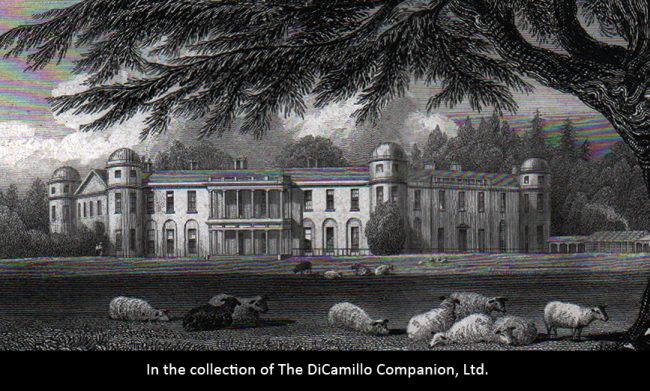
An 1829 engraving of the house from "Neale's Views of Seats"
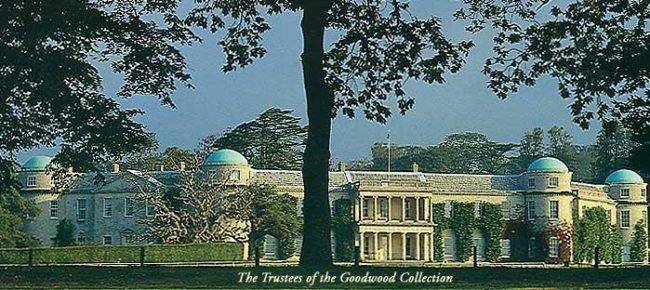
The house today
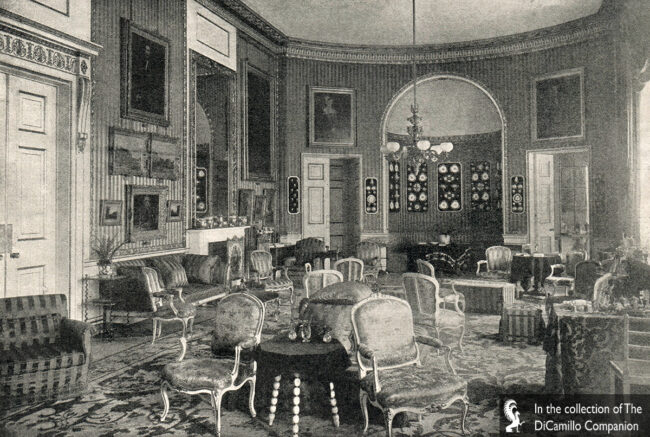
The Yellow Drawing Room from the Aug 2, 1905 edition of "The Sketch."
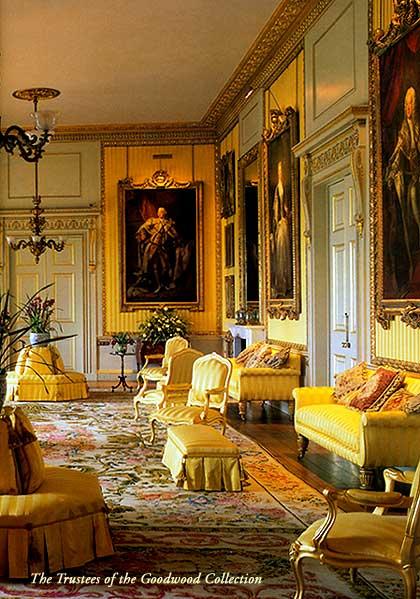
The Yellow Drawing Room today
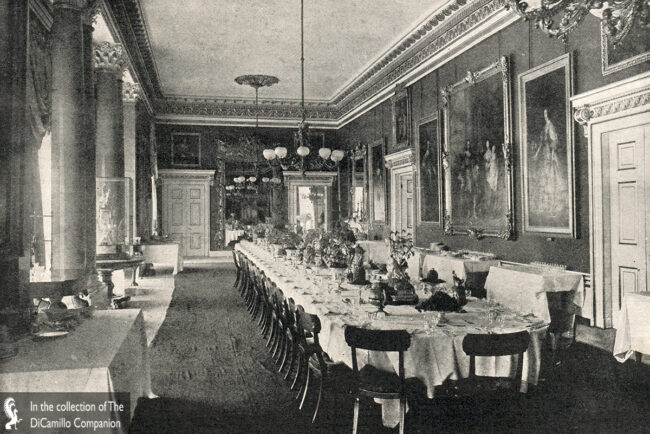
The State Dining Room from the Aug 2, 1905 edition of "The Sketch." This photo shows the room before its restoration to its original Egyptian decoration.
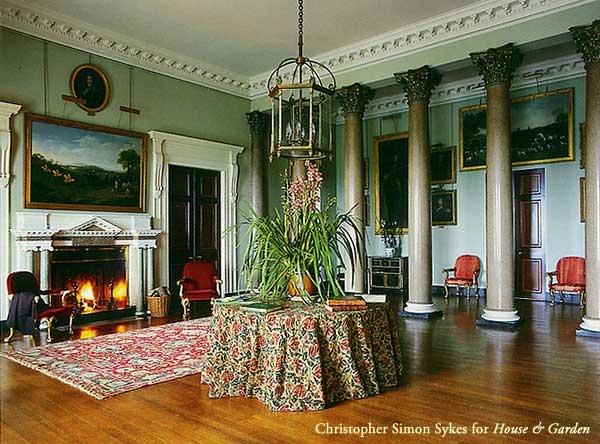
The front hall
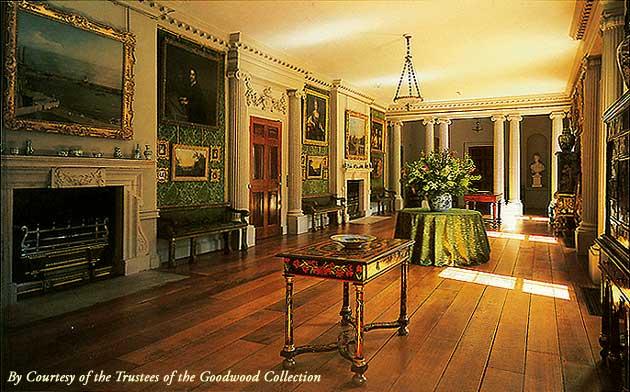
The Long Hall
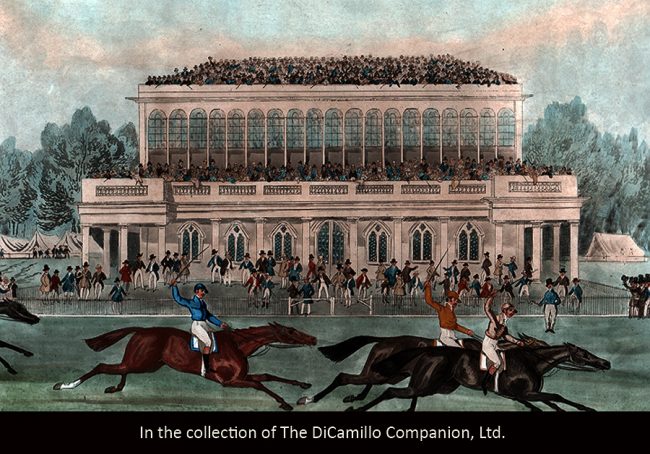
"Race for the Gold Cup," a hand-colored 1836 aquatint of racing at Goodwood.
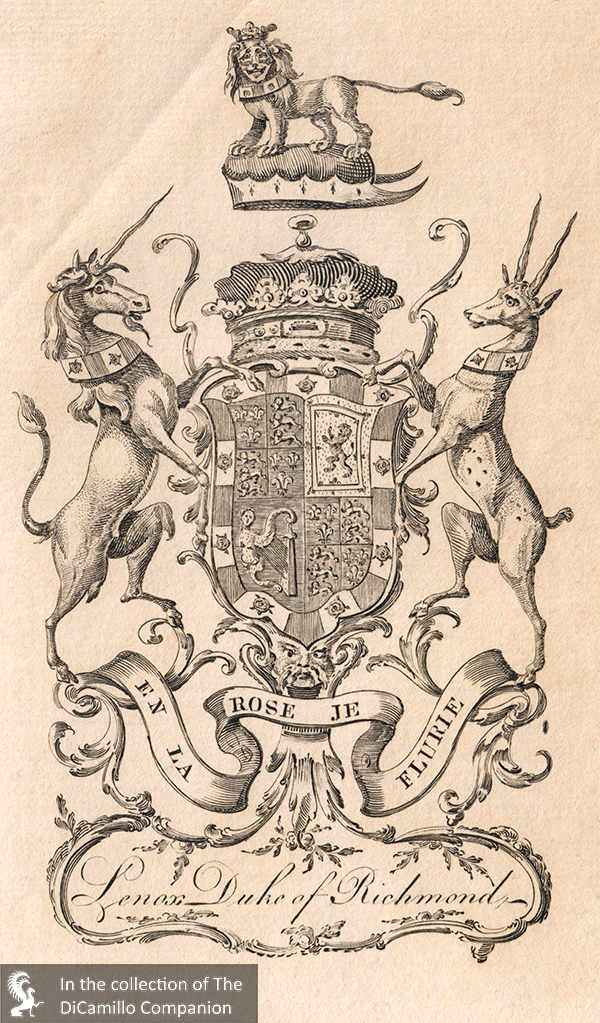
Engraving of the coat of arms of the 1st Duke of Richmond from the Jan 1766 issue of "The Universal Magazine"
House & Family History: A hunting lodge was built at "Godinwood" in 1616-17 by the 13th Earl of Northumberland. The 1st Duke of Richmond (the natural son of King Charles II and his French mistress, Louise de Keroualle) rented the hunting lodge and then purchased the house and park in 1697. The 2nd Duke remodeled the house 1729-30 and gave it a classical appearance (the look that it has today). Roger Morris was the surveyor for this work, and also added the folly called Carne's Seat in 1743. The duke extended the house to the south, adding the south façade to a design believed to be by Matthew Brettingham (modeled on William Kent's Devonshire House, London). In 1771 the 3rd Duke engaged James Wyatt to remodel the north wing (demolished in the late 1960s, when it was discovered to be riddled with dry rot). In 1791 the family's London house, Richmond House, burned down. After the fire, the 3rd Duke decided to move his large art collection to Goodwood; he hired James Wyatt again, this time to add to wings to the house to provide proper space for his art collection. There is also evidence that John Nash worked at Goodwood, circa 1800-07, possibly helping the over-stretched James Wyatt. During the Victorian era, conservatories were added (they were demolished in the 20th century). Edward VII was a frequent visitor to Goodwood in the early 20th century; it was during this time that the 7th Duke refurbished many of the interiors. The 3rd Duke was British ambassador to the court of Louis XV between 1765 and 1766; it was during his ambassadorship that he acquired much French furniture for Goodwood, including the Gobelins tapestries that originally formed part of a set of 30 ordered by Louis XV for Chateau de Marly (today in the tapestry drawing room at Goodwood). The tapestry drawing room has been the scene of more Privy Council meetings than any other private house in the 20th century: Edward VII on August 1, 1908; George V on July 31, 1924; and three meetings in the reign of Elizabeth II. The music room has a fine chimneypiece designed by William Kent and originally installed in Richmond House, London (it is identical to the two chimneypieces at the ends of the gallery at Chiswick House in London). The columns in the front hall are of Guernsey granite, shipped from Guernsey on the 3rd Duke's yacht. In 1814 Tsar Alexander I came to Goodwood for breakfast as part of his tour of England. The famous Egyptian State Dining Room, which contains one of the largest expanses of scagliola in the country, was created 1802-06 to James Wyatt's designs by Joseph Allcott for the 3rd Duke. The dining room was the first interior in Britain to be based on the illustrations in "Planches du Voyage dans la Basse et la Haute Egypte" by Baron Vivant Denon, who accompanied Napoleon on his Egyptian campaigns, 1798-99 (his drawings of ancient Egyptian monuments ignited a craze in Europe for the Egyptian taste). The 3rd Duke was an extraordinary man: he founded the Royal Ordnance Survey; had a sculpture gallery built at Richmond House in London to allow young students to draw anatomy; distinguished himself at the Battle of Minden and became a major general at the age of 26 (in 1796 he was made a field marshal); was ambassador extraordinary to the court of Louis XV between 1765 and 1766; was appointed secretary of state in the south in 1766; was a privy councilor, and, from 1782, master of the ordnance; submitted a bill for universal male suffrage; and supported the independence of the American colonies (in support of the American cause he sailed his yacht, flying the American flag, through the British fleet anchored at Spithead). The 4th Duke was an ADC to George III (in 1814 he became a full general). In 1807 he was appointed lord lieutenant of Ireland, where his young secretary was Arthur Wellesley, later 1st Duke of Wellington. In 1818 the duke was appointed governor general of Canada. He died of rabies the following year, having been bitten by a pet fox. The 5th Duke served in the Peninsula War as ADC to the Duke of Wellington. He later became postmaster general and ADC to Queen Victoria. The 6th Duke built over 200 cottages and houses for his tenants and employees, installed a gas works to improve heating and lighting in Goodwood, and a water pumping station. The 5th and last Duke of Gordon of that creation died in 1836. His sister, Charlotte, had much earlier married the 4th Duke of Richmond. Their son, the 5th Duke of Richmond, inherited the large Gordon estates in Scotland. In 1876 Queen Victoria recreated the dukedom of Gordon for the 6th Duke, who was one of her favorites. The 8th Duke served in the South African war as ADC to Field Marshal Earl Roberts. During World War I he contracted polio and was unable to walk for the rest of his life. During World War II Goodwood House served as a hospital. The 9th Duke founded, in 1948, the famous Goodwood Motor Racing Circuit. Today the Goodwood Estate is comprised of 12,000 acres, including the Racing Circuit, a hotel and country club, and the Aerodrome, a former World War II fighter station. Historian Stella Tillyard’s popular 1994 book, "Aristocrats: Caroline, Emily, Louisa, and Sarah Lennox, 1740-1832," tells the amazing stories of the four aristocratic Lennox sisters, daughters of the 2nd Duke of Richmond, and their extended families. The book was followed up in 1999 with the equally successful TV mini-series of the same name (the TV series was not filmed here). In 1998, when Bentley was separated from Rolls-Royce, the new Rolls-Royce was purchased by BMW. The German auto company received no assets (it purchased only the name) and so had to start manufacturing Rolls-Royces from scratch. It built a $130 million green factory designed by British architect Nicholas Grimshaw on the Goodwood Estate, thus adding a new chapter to the history of the automobile at Goodwood. The 3rd Duke of Richmond was described by Rosemary Baird, writing in "Goodwood: Art and Architecture, Sport and Family," as being someone "...who thought for himself; full of ideas...a true figure of the Enlightenment..."
Collections: Circa 1725 the bankrupt Irish impresario Owen McSwinney commissioned a number of different Italian artists to paint a series of 24 paintings of imaginary tombs of "illustrious Personages who flourish'd in England" after the Glorious Revolution of 1688. The series was intended for the 2nd Duke of Richmond and, though the series was never completed, 10 of the canvases were installed in the duke's dining room at Goodwood. One painting in the series, by Sebastiano and Marco Ricci showing the tomb of William Cavendish, who became the 1st Duke of Devonshire in 1694, is today in the collection of the Barber Institute of Fine Arts, Birmingham. The 3rd Duke of Richmond was England's greatest patron of Sèvres porcelain. He commissioned a set for Goodwood that is unique in England because it was actually commissioned at the factory in 1765, and because the duke played an important role in the choice of decoration. A set known as the Waterloo China is believed to have been made for the 4th Duchess by the people of Brussels in grateful acknowledgement of the ball held by her on June 15, 1815. The ball was meant to fool Napoleon into believing the Allies were frivolous and unready for battle; the bluff worked and the triumph at Waterloo followed three days later. The Egyptian Dining Room contains candelabra made expressly for the room in the early 19th century by Rundell & Bridge; the stems are formed of triads of formalized telemones holding tablets bearing hieroglyphics mounted upon bases supported by winged sphinxes, all finished off with table bases bearing the Richmond coat of arms. Early in the morning of January 13, 2016 an intruder broke into Goodwood, attacked the Earl of March (later 11th Duke of Richmond), forced the countess to open a safe, tied them both up, and left with approximately £700,000 of jewelry. Among the pieces stolen was an emerald and diamond ring given by Charles II to his mistress, Louise de Kérouaille, the Duchess of Portsmouth (the dukes of Richmond are descended from this couple). Also stolen was an exceptional 1820 diamond tiara worth £400,000, antique Rolex and Girard-Perregaux watches, and jeweled bracelets, necklaces, and earrings. The earl and countess were discovered around 6:30 AM when staff began to arrive for work.
Garden & Outbuildings: The Goodwood Estate is a major center for sports, most particularly as the venue for the Goodwood Racecourse, home of Glorious Goodwood, the famous flat racing (horseracing) festival, one of the highlights of the English social season. The racecourse is also home to two of the UK's 31 Group One flat races, the Nassau Stakes and the Sussex Stakes. There are also two major auto racing events held each year at Goodwood: The Goodwood Festival of Speed is a major event in the British motor racing calendar. Commonly abbreviated as FoS, and referred within the United Kingdom as the Festival of Speed, the race is an annual hill climb featuring historic racing vehicles that was started in 1993. Usually held in late June or early July, the event is scheduled to fit into the motor racing calendar and to avoid a date clash with the Formula One season. The FoS gets an average of 100,000 people per day over the three days it is held. The Goodwood Revival is a three-day festival held each September for the types of cars and motorcycles that would have competed during the circuit's original period: 1948-66. It is one of the world's most popular motor race meetings and the only UK event which recreates the golden era of motor sport from the 1950s and 1960s (between 1948 and 1966 Goodwood hosted contemporary racing of all kinds, including Formula One, the famous Goodwood Nine Hours race, and the celebrated Tourist Trophy sports car race). The grounds are also home to a golf course and The Kennels, a members-only clubhouse built to the designs of James Wyatt in 1787 for the hounds of the 3rd Duke of Richmond. The estate contains many follies and outbuildings, including the famous Grade II*-listed Carne's Seat, 1743, by Roger Morris. James Wyatt probably designed the Gothick style cottages and certainly designed the Valdoe Lodges, the kennel lodges, the orangery, and Molecomb, the dower house. The shell house, considered one of the best in England, was designed in the 1730s by the 2nd Duchess of Richmond and her daughters, Caroline and Emily, the latter made famous in "Aristocrats," the Stella Tillyard book (and later the TV mini-series). The duchess and her daughters probably laid out the designs for the interiors of the cottage using sketches on sheets of paper, with the actual work being done by estate workers. The sweet Gothick Dairy was probably built in the 1790s; it may have been later altered to the designs of John Nash in the early 19th century. The 2nd Duke was famous for the menagerie he kept of lions, bears, tigers, ostriches, eagles, and monkeys on the Goodwood Estate. He was a keen huntsman; in 1727 the earliest set of written rules for the hunt was penned for the duke, who also founded famous and very prestigious Charlton Hunt (the hunt no longer exists, but is commemorated today with the Charlton House Restaurant on the Goodwood Racecourse). Most appropriately, the duke was also master of the horse to George II. Beginning in the 1760s, the 3rd Duke acquired four different moose from North America: in 1766 a young female was sent to the duke from Quebec by General Carleton, governor-general of Canada, and in 1770 the duke acquired a male moose from General Carleton, the first to enter England. The male moose was painted by Stubbs in 1770; the artist stayed for nine months at Goodwood, producing a variety of paintings for the duke (the painting of the male moose is today in the collection of the Hunterian Art Gallery, Glasgow). The 3d Duke was an enlightened manager of the Goodwood Estate and added enormous amounts of land to the estate, bringing the total holdings to 17,000 acres at his death. He was also an early member of the Jockey Club, which was founded in London in 1750 (it soon was relocated to Newmarket, where it remains today). In 1998, when it bought the Rolls-Royce automobile brand, BMW only purchased the name—no physical assets were a part of the deal, which meant that BMW had to build a factory and ancillary support buildings from the ground up. The German auto manufacturer engaged British architect Nicholas Grimshaw for the job, who designed a $130 million greenfield factory on a 100-acre site on the Goodwood Estate, which today produces the most sophisticated Rolls-Royces ever built.
Architect: William Oldham Chambers
Date: Circa 1760Architect: Matthew Brettingham the Elder
Designed: Added South Façade for 2nd DukeArchitect: John Nash
Date: Circa 1800-07Vitruvius Britannicus: C. III, pls. 51-54, 1725.
John Preston (J.P.) Neale, published under the title of Views of the Seats of Noblemen and Gentlemen in England, Wales, Scotland, and Ireland, among other titles: 2.S. Vol. V, 1829.
Country Life: XVIII, 198; Lxxii, 40, 66, corr. 167, corr. 194, corr. 250, corr. 307, 638, corr. 701; xcv, 242; cxii, 2094; corr. cLxxi, 1058; opening to public, cLiv, 316; 8/91.68; 30/97.44; restoration 39/97.78; shell grotto, 39/97.86; stables, 39/97.90; new wing - architect's design T&C, 39/97.124; trees in the park, 39/97.88; Egyptian dining room, 17/98.84;
Title: Aristocrats: The Illustrated Companion to the Television Series
Author: Tillyard, Stella
Year Published: 1999
Reference: pg. 32
Publisher: London: Weidenfeld & Nicolson
ISBN: 0297825054
Book Type: Hardback
Title: Goodwood: Art and Architecture, Sport and Family
Author: Baird, Rosemary
Year Published: 2007
Reference: pgs. 101-103, 105, 145, 150, 155, 186, 205, 207
Publisher: London: Frances Lincoln Limited
ISBN: 9780711227699
Book Type: Hardback
Title: Landmarks of Britain: The Five Hundred Places that Made Our History
Author: Aslet, Clive
Year Published: 2005
Reference: pg. 359
Publisher: London: Hodder & Stoughton
ISBN: 0340735104
Book Type: Hardback
Title: Barber Institute of Fine Arts, The
Author: Verdi, Richard
Year Published: 1999
Reference: pg. 66
Publisher: London: Scala Publishers
ISBN: 1857592204
Book Type: Softback
Title: V&A Guide to Period Styles: 400 Years of British Art and Design, The
Author: Jackson, Anna; Hinton, Morna
Year Published: 2002
Reference: pg. 91
Publisher: London: V&A Publications
ISBN: 0810965909
Book Type: Hardback
Title: Buildings of England: Sussex, The
Author: Pevsner, Nikolaus; Nairn, Ian
Year Published: 1973
Reference: pgs. 227-229
Publisher: London: Penguin Books
ISBN: 0140710280
Book Type: Hardback
Title: Goodwood House Guidebook
Author: NA
Year Published: NA
Publisher: Susex: Goodwood House
ISBN: NA
Book Type: Softback
House Listed: Grade I
Park Listed: Grade I
Current Seat / Home of: Charles Gordon-Lennox, 11th Duke of Richmond, 11th Duke of Lennox, 11th Duke of Aubigny, and 6th Duke of Gordon.
Past Seat / Home of: Charles Lennox, 2nd Duke of Richmond, 2nd Duke of Lennox, and 2nd Duke of Aubigny, 1722-50; Field Marshal Charles Lennox, 3rd Duke of Richmond, 3rd Duke of Lennox, and 3rd Duke of Aubigny, 1750-1806; Charles Lennox, 4th Duke of Richmond, 4th Duke of Lennox, and 4th Duke of Aubigny, 1806-19; Charles Gordon-Lennox, 5th Duke of Richmond and 5th Duke of Lennox, 1819-60; Charles Henry Gordon-Lennox, 6th Duke of Richmond, 6th Duke of Lennox, and 1st Duke of Gordon, 1860-1903; Charles Henry Gordon-Lennox, 7th Duke of Richmond, 7th Duke of Lennox, and 2nd Duke of Gordon, 1903-28; Charles Henry Gordon-Lennox, 8th Duke of Richmond, 8th Duke of Lennox, and 3rd Duke of Gordon, 1928-35; Frederick Charles Gordon Lennox, 9th Duke of Richmond, 9th Duke of Lennox, 9th Duke of Aubigny, and 4th Duke of Gordon, 1935-89; Charles Henry Gordon-Lennox, 10th Duke of Richmond, 10th Duke of Lennox, 10th Duke of Aubigny, and 5th Duke of Gordon, 1989-2017.
Current Ownership Type: Individual / Family Trust
Primary Current Ownership Use: Private Home
House Open to Public: Yes
Phone: 01243-755-048
Fax: 01243-755-005
Email: [email protected]
Website: https://www.goodwood.com/
Awards: 2023 Tatler Country House Award for Best Bright Young Things.
Historic Houses Member: Yes